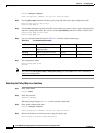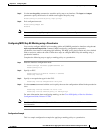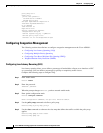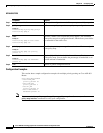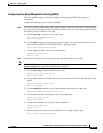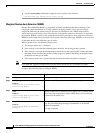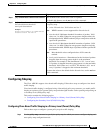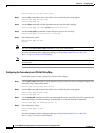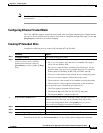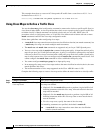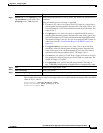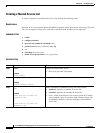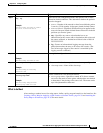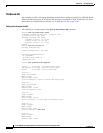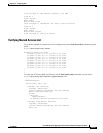
24-48
Cisco ASR 901 Series Aggregation Services Router Software Configuration Guide
OL-23826-09
Chapter 24 Configuring QoS
Configuring Quality of Service (QoS)
Router(config)# policy-map
output-policy
Step 2 Use the class command to specify the traffic class to which the policy map applies.
Router(config-pmap)# class class1
Router(config-pmap-c)#
Step 3 Use the shape command to define algorithm and rate used for traffic shaping.
Router(config-pmap-c)# shape average
mean-rate
burst-size
Step 4 Use the service-policy command to attach the policy map to the class map.
Router(config-pmap-c)# service-policy
policy-map
Step 5 Exit configuration mode.
Router(config-pmap-c)# end
Router#
Note You can use the show policy-map command to verify your configuration.
For more information about configuring shaping, see Regulating Packet Flow on a Per-Class
Basis---Using Class-Based Traffic Shaping.
Note The Cisco ASR 901 does not support all of the commands described in the IOS Release 12.2SR
documentation.
Configuring the Secondary-Level (Child) Policy Map
Follow these steps to create a child policy map for traffic shaping.
Step 1 Use the policy-map command to specify the policy map for which you want to configure shaping and
enter policy-map configuration mode.
Router(config)# policy-map
output-policy
Step 2 Use the class command to specify the traffic class to which the policy map applies.
Router(config-pmap)# class class1
Router(config-pmap-c)#
Step 3 Use the bandwidth command to specify the bandwidth allocated to the policy map. You can specify the
bandwidth in kbps, a relative percentage of bandwidth, or an absolute amount of bandwidth.
Router(config-pmap-c)# bandwidth percent 50
Step 4 Exit configuration mode.
Router(config-pmap-c)# end
Router#
For more information about configuring shaping, see Regulating Packet Flow on a Per-Class
Basis---Using Class-Based Traffic Shaping.



